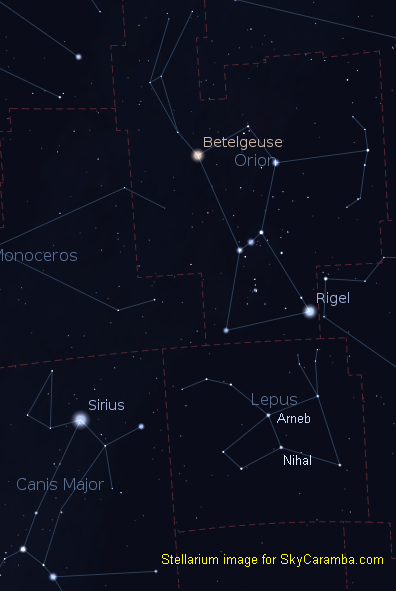SkyCaramba weekly astronomy blog for the week ending February 25, 2012
At the feet of Orion is a dim and not so well known constellation called Lepus. It’s a hare. Maybe you didn’t even know there’s a rabbit in the celestial sphere. Orion is fairly high in the sky at sunset for northern hemisphere observers this time of year. Look just below it to see Lepus.
The ancient legends say that Orion liked to hunt rabbits. The one at his feet may be  one he has just killed. Some legends associated the rabbit with the moon and the sun chased the moon around the sky. That may be another reason Orion has caught a rabbit. Other old stories tell of the rabbit being where it is to avoid being caught by a bird of prey. Lepus is on the opposite side of the sky as Aquila the eagle.
one he has just killed. Some legends associated the rabbit with the moon and the sun chased the moon around the sky. That may be another reason Orion has caught a rabbit. Other old stories tell of the rabbit being where it is to avoid being caught by a bird of prey. Lepus is on the opposite side of the sky as Aquila the eagle.
An Anglo-Saxon story connects the Lepus in our sky to the Easter Bunny story. The goddess of spring, Ostara, turned a great bird into a hare. It couldn’t fly anymore but Ostara gave it great speed. Ostara also lets the former bird lay eggs once a year. And that’s why there are Easter eggs.
The brightest star in Lepus is Arneb. Its name is Arabic for hare. The next brightest star in Lepus is Nihal which is Arabic for camels slacking for thirst. Centuries ago, three other stars were also called by this name.
Lepus contains a rare wonder among stars. The Crimson Star or R Leporis is a carbon star. It’s very cool and therefore very red. It’s also a variable star ranging from 5.5 (barely visible to the naked eye) to 10.5 (requiring dark skies and a small telescope). It goes from one extreme to the other and back over a 14 month period. This is the same kind of variable as Mira.
Take a look at M79 in a telescope if you can. It’s a globular cluster just south of Lepus. It kind of looks like a ball of stars. Some astronomers believe this cluster actually came from another galaxy passing close to the Milky Way.
Lepus is harder to see the farther north you go. North of the Arctic Circle, you’ll only see some of its stars. A little south of it and you only see it for a few hours a night. Go as far south as central Brazil, Madagascar, or northern Australia and you can watch Lepus rise in the east, go over your head, and set in the west. Farther south and it’s a slightly northern constellation. You’ll actually be looking at it upside down there.
Wherever you view from, I hope you enjoy it. ¡Sky Caramba!